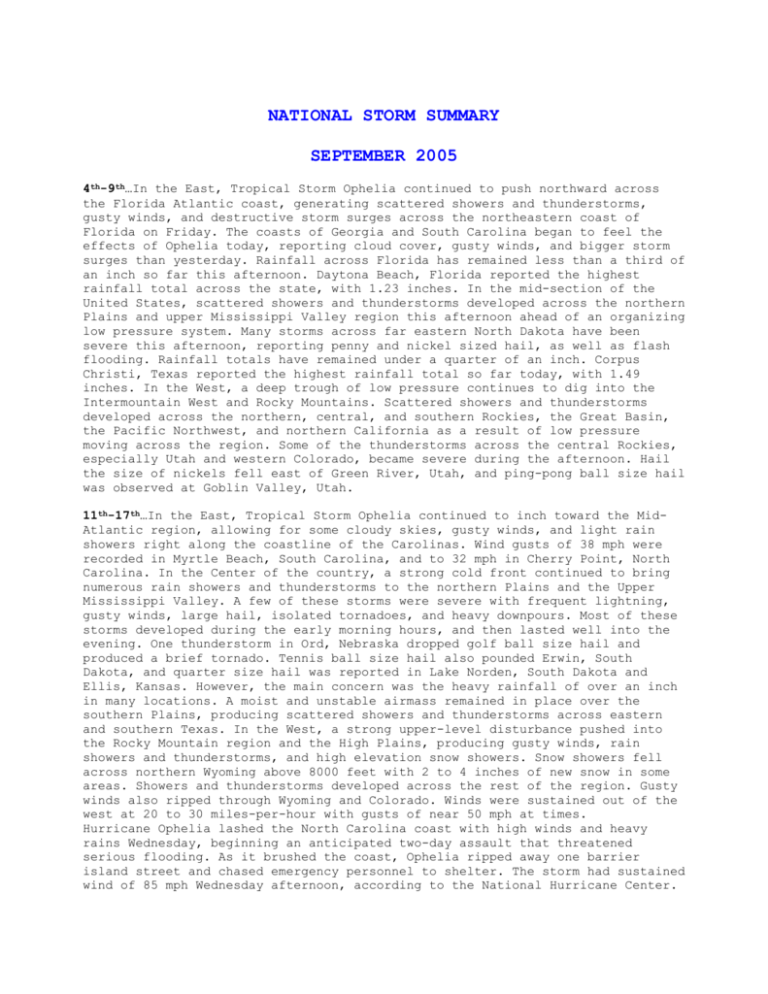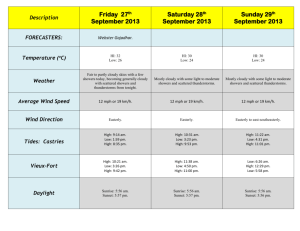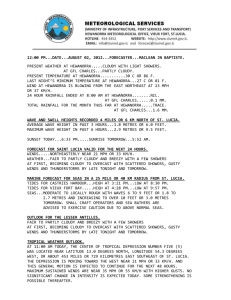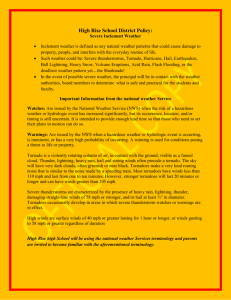NATIONAL STORM SUMMARY
advertisement

NATIONAL STORM SUMMARY SEPTEMBER 2005 4th-9th…In the East, Tropical Storm Ophelia continued to push northward across the Florida Atlantic coast, generating scattered showers and thunderstorms, gusty winds, and destructive storm surges across the northeastern coast of Florida on Friday. The coasts of Georgia and South Carolina began to feel the effects of Ophelia today, reporting cloud cover, gusty winds, and bigger storm surges than yesterday. Rainfall across Florida has remained less than a third of an inch so far this afternoon. Daytona Beach, Florida reported the highest rainfall total across the state, with 1.23 inches. In the mid-section of the United States, scattered showers and thunderstorms developed across the northern Plains and upper Mississippi Valley region this afternoon ahead of an organizing low pressure system. Many storms across far eastern North Dakota have been severe this afternoon, reporting penny and nickel sized hail, as well as flash flooding. Rainfall totals have remained under a quarter of an inch. Corpus Christi, Texas reported the highest rainfall total so far today, with 1.49 inches. In the West, a deep trough of low pressure continues to dig into the Intermountain West and Rocky Mountains. Scattered showers and thunderstorms developed across the northern, central, and southern Rockies, the Great Basin, the Pacific Northwest, and northern California as a result of low pressure moving across the region. Some of the thunderstorms across the central Rockies, especially Utah and western Colorado, became severe during the afternoon. Hail the size of nickels fell east of Green River, Utah, and ping-pong ball size hail was observed at Goblin Valley, Utah. 11th-17th…In the East, Tropical Storm Ophelia continued to inch toward the MidAtlantic region, allowing for some cloudy skies, gusty winds, and light rain showers right along the coastline of the Carolinas. Wind gusts of 38 mph were recorded in Myrtle Beach, South Carolina, and to 32 mph in Cherry Point, North Carolina. In the Center of the country, a strong cold front continued to bring numerous rain showers and thunderstorms to the northern Plains and the Upper Mississippi Valley. A few of these storms were severe with frequent lightning, gusty winds, large hail, isolated tornadoes, and heavy downpours. Most of these storms developed during the early morning hours, and then lasted well into the evening. One thunderstorm in Ord, Nebraska dropped golf ball size hail and produced a brief tornado. Tennis ball size hail also pounded Erwin, South Dakota, and quarter size hail was reported in Lake Norden, South Dakota and Ellis, Kansas. However, the main concern was the heavy rainfall of over an inch in many locations. A moist and unstable airmass remained in place over the southern Plains, producing scattered showers and thunderstorms across eastern and southern Texas. In the West, a strong upper-level disturbance pushed into the Rocky Mountain region and the High Plains, producing gusty winds, rain showers and thunderstorms, and high elevation snow showers. Snow showers fell across northern Wyoming above 8000 feet with 2 to 4 inches of new snow in some areas. Showers and thunderstorms developed across the rest of the region. Gusty winds also ripped through Wyoming and Colorado. Winds were sustained out of the west at 20 to 30 miles-per-hour with gusts of near 50 mph at times. Hurricane Ophelia lashed the North Carolina coast with high winds and heavy rains Wednesday, beginning an anticipated two-day assault that threatened serious flooding. As it brushed the coast, Ophelia ripped away one barrier island street and chased emergency personnel to shelter. The storm had sustained wind of 85 mph Wednesday afternoon, according to the National Hurricane Center. Ophelia was moving northeastward at just 7 mph after following a looping, meandering course along the coast since it formed off Florida. Authorities expected the storm's passage across North Carolina to take some 48 hours from the start of rainfall on the southeastern coast Tuesday afternoon to the storm's anticipated exit off the Outer Banks and back into the Atlantic late Thursday. By mid-afternoon Wednesday, about 12 inches of rain had fallen on Oak Island at the mouth of the Cape Fear River, said meteorologist Jeff Orrock with the National Weather Service in Raleigh. Wind gusts reaching 84 mph prompted Carolina Beach to pull emergency personnel off the roads, town spokeswoman Valita Quattlebaum said. On Ocean Isle Beach, a 50-foot section of beachfront road was washed out by heavy surf and the only bridge to the barrier island was closed. Police had evacuated to an off-island safe house on Tuesday. At 5 p.m. EDT, Ophelia's large eye was centered about 40 miles east of Wilmington and about 50 miles southwest of Cape Lookout on the Outer Banks. Hurricane-force wind of at least 74 mph extended 50 miles out from the center and forecasters said some strengthening was possible. 18th-24th…There were two unconfirmed reports of tornado touchdowns on Wednesday evening as a severe thunderstorm pushed through parts of central and eastcentral Minnesota, pelting the area with hail and knocking down trees in its path. The storm included straight-line winds with gusts up to 70 mph. There were two reports of tornado touchdowns: a trained weather spotter reported a touchdown in Atwater at 6:15 p.m., and a member of the public reported a tornado touchdown in Brooklyn Park about an hour later. Neither reports could be verified until a damage survey could be completed, said Beau Gjerdingen, of the National Weather Service. There were also numerous reports of funnel clouds throughout the metro area and surrounding suburbs. Early reports of damage showed downed trees and power lines and hail damage in several areas, including Brooklyn Park and Maple Grove. Power outages also were reported in Albertville, Maple Grove and Rogers. Xcel Energy reported about 56,000 customers were without power in the west area of the Twin Cities, and about 11,000 customers had no power in the east-metro area. 25th-30th…The remnants of Tropical Depression Rita moved north Sunday into the Mississippi, Tennessee and Ohio valleys with flooding rains and severe thunderstorms. Downpours caused flooding across much of west and central Mississippi, with 3 feet of water in some low-lying areas. Gusts nearing 60 mph were recorded in the state and downed trees were reported in Port Gibson. Downed trees and power lines also were reported in the Memphis, TN, area and flash floods soaked much of western Tennessee. Eastern Louisiana and western Arkansas also experienced strong storms and gusty winds from Rita's remnants. Farther north, showers and thunderstorms formed from Minnesota to central New York. In the EAST, scattered showers and thunderstorms occurred across South Carolina, Georgia, and Florida in association with an upper-level disturbance over the area on Wednesday. Rainfall totals generally ranged from a quarter inch to 1.50 inches, although some higher amounts were reported in Florida. One severe storm dropped half-dollar sized hail on Moore Haven, Florida this afternoon. Meanwhile, rain ahead of a cold front began to push into the Ohio Valley and Great Lakes Region. In the Central United States, a strong cold front plowed southeastward across the Upper Midwest, Mississippi Valley, and central Plains. Ahead of the front, widespread rain occurred from the Upper Peninsula of Michigan southward through northern Missouri. This front also produced thunderstorms over southern Missouri, northern Arkansas, and eastern Oklahoma this afternoon. Some of these storms became severe. Wind gusts of 65 mph were experienced in Everton, Missouri, which tore thick branches off of trees. Meanwhile, behind the cold front, gusty winds occurred throughout the central Plains. Wind gusts of 30 to 45 mph were common across Oklahoma, Kansas, and Nebraska.







